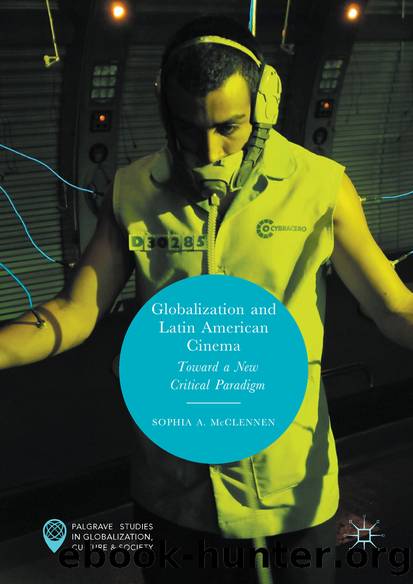Globalization and Latin American Cinema by Sophia A. McClennen

Author:Sophia A. McClennen
Language: eng
Format: epub
ISBN: 9783319570600
Publisher: Springer International Publishing
Neoliberalism and the New Argentine Cinema
The political struggles of the 1960s and 1970s, both in terms of economic and cultural practices, were profoundly revolutionary, influenced as they were by the success of the Cuban Revolution, the election of Salvador Allende in Chile, and the guerrilla struggles of Che Guevara, but they were soon tempered by the wave of dictatorships that moved across the region beginning with the Brazilian coup of 1964. Argentina would enter full-blown military rule in 1976. Before long, the constant state of terror led many on the left to focus on the most visible signs of state brutality: the torture, the disappearances, the exiles, etc. Correspondingly, a number of third cinema-influenced filmmakers, most of whom were in exile, made films that critiqued these militarized states. Argentine filmmaker Héctor Oliveraâs No habrá más penas ni olvido (Funny Dirty Little War, 1983) was released, for instance, in 1983, the last year of the junta and much post-junta Argentine cinema of the 1980s and 1990s was dedicated to rescuing the repressed past.
Falicov notes that âduring the transition to democracy, film production was encouraged by the state and supported by private sources of fundingâ thereby almost doubling national film production from âapproximately 15 films during the dictatorship era to up to 25 films until 1989.â 40 The films of the transition were greatly influenced by Manuel AntÃn, who headed the Instituto Nacional de Cine (INC; National Cinema Institute) from 1983 to 1989, and who has been lauded as the force behind the Argentine cinema boom. Falicov notes that the films of this era, though, were often aimed at an international middle class and âgeared for prestigious film festival exhibition rather than a broad national audience.â 41 While the films often dealt with the recent past, recovering traumatic memory after a period of censorship, they often were âart houseâ in style. AntÃn supported such high-brow products to purpose, since both he and then-president Raúl AlfonsÃn (1983â1988) saw Argentine cinema as a way of changing the international view of Argentina and encouraging foreign trade and investment. AlfonsÃn âoften brought a set of Argentine films on video as a gift when visiting other foreign heads of state.â 42 And AntÃn explicitly referred to the US motto that âtrade follows filmâ from the 1920s as a motive for exporting images of Argentina abroad. 43
The âNewâ Argentine Cinema that emerged in the late 1990s after the release of Pizza, birra, faso marked a significant shift from this earlier phase in that the films were less overtly committed to reconsiderations of the past, and the context for these films was no longer a transition government, but rather the more openly neoliberal moment of Menemâs presidency (1989â1999). Within the first two years of Menemâs presidency, Argentina became the country with the largest number of privatizations in the world. 44 In addition to privatization, Menem followed the IMF mandate to reduce state spending, drastically cutting the budgets for education and culture. The Menem administration immediately cut funding for the arts significantly.
Download
This site does not store any files on its server. We only index and link to content provided by other sites. Please contact the content providers to delete copyright contents if any and email us, we'll remove relevant links or contents immediately.
Call Me by Your Name by André Aciman(20351)
Ready Player One by Cline Ernest(14496)
How to Be a Bawse: A Guide to Conquering Life by Lilly Singh(7364)
Wiseguy by Nicholas Pileggi(5649)
The Kite Runner by Khaled Hosseini(5061)
On Writing A Memoir of the Craft by Stephen King(4847)
Audition by Ryu Murakami(4822)
The Crown by Robert Lacey(4710)
Call me by your name by Andre Aciman(4599)
Gerald's Game by Stephen King(4556)
Harry Potter and the Cursed Child: The Journey by Harry Potter Theatrical Productions(4428)
Dialogue by Robert McKee(4306)
The Perils of Being Moderately Famous by Soha Ali Khan(4156)
Dynamic Alignment Through Imagery by Eric Franklin(4100)
Apollo 8 by Jeffrey Kluger(3621)
Seriously... I'm Kidding by Ellen DeGeneres(3564)
The Inner Game of Tennis by W. Timothy Gallwey(3557)
How to be Champion: My Autobiography by Sarah Millican(3544)
Darker by E L James(3463)
